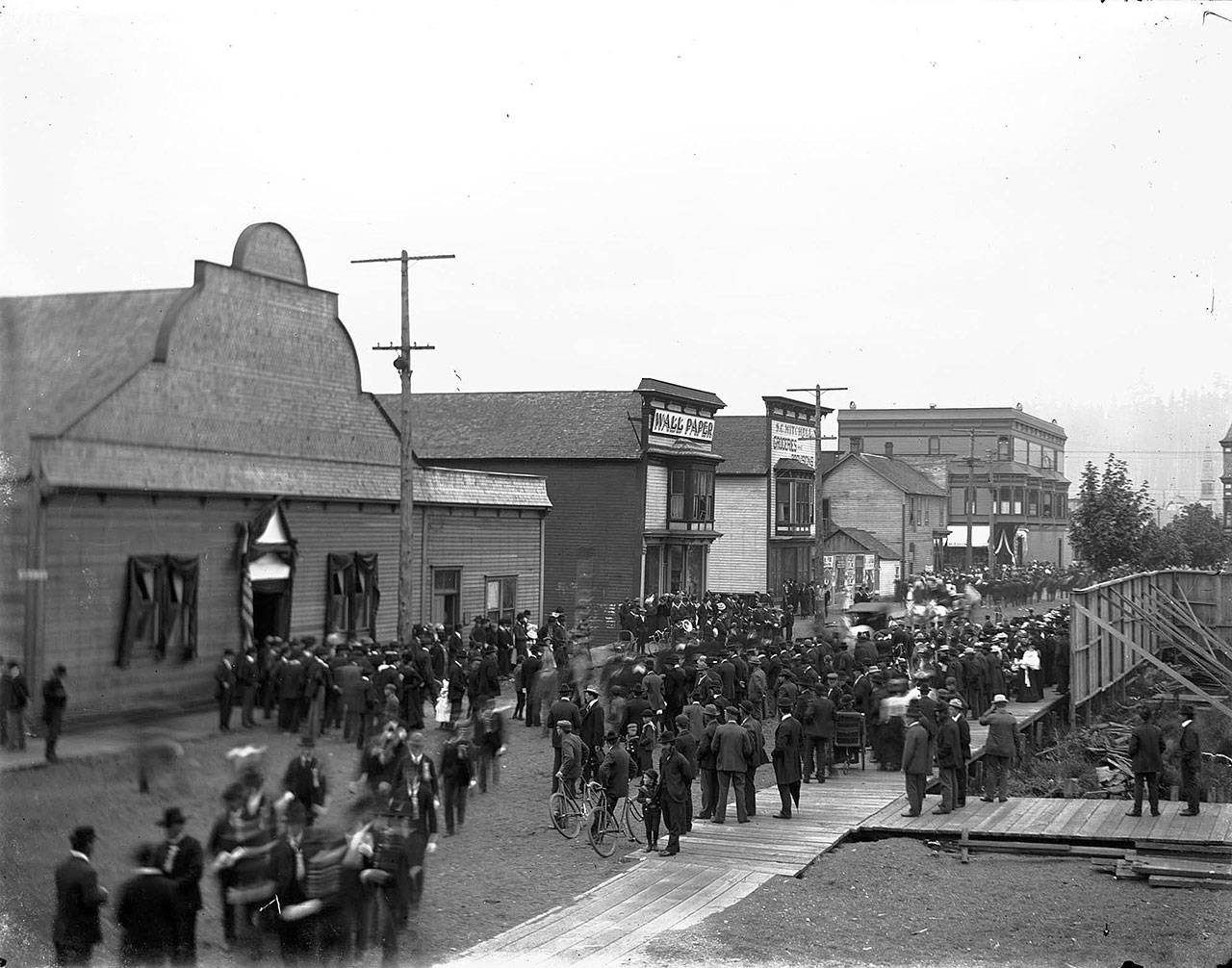If there is one thing that history buffs love — and often frustrated by — it is the mystery presented by an unidentified photograph, and this view from the Jones Photo Collection of H Street looking northwest from Hume (present-day State) Street is one such image. This is a fascinating look at Aberdeen two years before most of the wooden structures that comprised the central business district were destroyed in the Great Fire of October 16, 1903.
The unique shingled structure on the far left draped in black bunting was Fireman’s Hall. It was built in 1899 by contractor Hugh George and opened that May with seating for 1,000. One of the first programs was a grand ball presented by the Aberdeen Cornet Band as a fund raiser to purchase uniforms for the band members to wear in the Fourth of July parade. The square annex connected to the building was a cloakroom added in 1901. Firemen’s Hall was a popular meeting place for lodges, veteran and military organizations, as well as the site of countless dances, balls and public meetings. In 1905 the building was procured by Mike Goldsmith, a local businessman and character of sorts, who added “fancy fixtures” to the structure and christened it the Anheuser Music Hall. The Grand Opening on May 22 featured Miss Hazel Kirke “The Nome Nugget,” and for the next two years the Anheuser Music Hall was a site for wild night life. In 1907, as he lay dying from “splenic trouble” Goldsmith sold the building to his brother, Mose, who renamed it the Empire Theater, offering vaudeville performances and moving pictures. In 1915 the theater closed and the building was remodeled into four storefronts. The structure was razed in the 1940s.
The next building in the photo, with the words “WALL PAPER” prominently displayed, housed McLafferty and Sons, a pioneering painting and wallpapering house. Arriving in 1891, David McLafferty was one of the first painter/decorators to offer his craft in Grays Harbor. This structure survived the Great Fire and was moved in 1915 to make way for a new post office building which still stands today.
Across the alley was the original site of Capt. S.C. Mitchell’s Cash Store. Mitchell was a retired sea captain and one of Aberdeen’s most successful early grocers. The Cash Store sold coffee, grains, meats, spices and other general staples, and, as the name implies, they accepted cash only. He later moved his store into the Cathcart Building at Market and G but retained ownership of the building seen here and used it for warehousing before it was destroyed in the Great Fire of 1903.
The gabled building, fronting on Heron Street and seen here from the rear, was the Western Union telegraph office, and the offices of Patterson & Locke, a real estate and insurance company. The building was destroyed in the Great Fire and in 1910 Aberdeen’s first “sky scraper,” the five-story Finch Building, was erected on the site.
Across Heron Street is the Weatherwax & Rowland building with its elaborate second-story bay windows. The building opened in the spring of 1901 with the ground floor rented to I. Harris & Sons dry goods store, the second floor held offices and the top story was where the Elks Club met the first and third Fridays of every month. On Oct. 16, 1902, the manager of I. Harris & Sons, George J. Wolff, purchased the business. Exactly one year later the building was destroyed in the Great Fire. Today this is the site of the far-less elaborate Arby’s restaurant.
Continuing further, the steeple of the Congregational Church at the corner of First and H Streets is visible in the distance, and on the extreme right is the imposing dark tower of the Hayes & Hayes Bank which took over the building in 1895 after the First National Bank of Aberdeen went into voluntary liquidation. Hayes & Hayes would meet a similar fate in 1927.
While it is impossible to be absolutely sure about the date and event, based on the buildings, the crowd, and by cross-referencing city directories, maps, newspapers and other photographs, it is likely that this photo was taken on the afternoon of Thursday, Sept. 19, 1901. Mayor William Anstie had proclaimed that a day of mourning in recognition of the funeral for President William McKinley, who had been assassinated 5 days earlier. In the proclamation, Anstie earnestly recommended that “from 12 o’clock noon of that day, all places of business be closed and that our citizens and people, as far as practicable, attend and participate in the memorial services to be held.” Among the day’s events were a parade of all fraternal and civic organizations that the Aberdeen Herald hailed as “the largest ever seen on Grays Harbor, and required twenty minutes to pass a given point,” followed by “excellent music and eloquent speakers” at Firemen’s Hall. Turnout was so great that the overflow crowd was sent to the Acme Opera House where additional speakers spoke articulately on the life of Our Martyred President.
Roy Vataja is the son of Finnish immigrants and is always on the prowl for photos and artifacts showing Aberdeen in various stages of her development.


